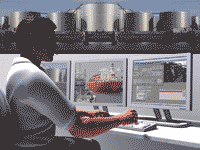
A Visual Aide
It pays to minimize false fire alarms. A new approach to monitoring may help.
- By Marc Barrera
- Aug 02, 2007
FALSE fire alarms are a costly problem. Beyond the financial loss due to downtime, the "cry wolf" factor can affect future response time to critical situations. In the oil industry, the potential for a false reading is especially plausible because of other contributing factors--from radiant sources such as solar radiation, flare reflection from Floating Production Storage and Off-loading (FPSOs) ships, hot CO2 emissions from pipeline pumping stations, and more. An offshore drilling platform's environment also can greatly limit or degrade a detection system's monitoring capabilities, as constant severe weather can bring heavy rain and ice.
Adrian Lloyd, MICROPACK Detection (Americas) Inc. sales manager, said the company's new third-generation Visual Flame Detector (VFD), Model FDS-301, has been designed to prevent false alarms and cut down costs. It easily integrates into a plant's pre-existing management system without the need for special cable installation or personnel training. "It integrates into the plant fire alarm system and the plant security system at the same time. It's really very easy for them to interface it into their system," he said. "We operate and send over standard video cable. So you can use your existing video cabling and your standard video interface."
Instead of working like an infrared or thermal monitor, this flame detector/CCTV camera doesn't use sensors to detect a fire through heat signature. Instead, it uses digital signal processing and software algorithms to recognize a flame in its view. "Essentially, we characterize what flames look like, and that's stored on a digital signal processor--a DSP chip within the detector," Lloyd said. "Then, when the fire is within the field of view of the camera, we process the image of what the camera has seen, compare that to what we profile, and if it matches, then the unit sends an alarm out and also sends out live video."
The device's programming allows it to differentiate between false alarm triggers, such as the flame on a relief flare or the glare of headlights from traffic. This differentiation ability allows the camera to be used in many other applications, such as aircraft hangers, petrochemical plants, gasoline transport loading terminals, and road traffic tunnels. But because it is a visually oriented product, obstruction is a primary concern. To combat this, the device has an Advanced Optical Verification feature that checks the camera lens for contamination or obstructions placed immediately in front of the camera.
Taking the Long View
The greatest advantage to using the VFD is its extended range. Because the device is camera-based, with the proper focal length lens it can monitor from up to 144 feet away, allowing it to safely continue providing crucial surveillance data if an incident should happen. "That's another advantage of using a camera, is that it can outperform other types of sensors, because we can actually just use different lenses to increase the image size," Lloyd said.
When a flame is detected, depending on its integration within the present control system, the device can trigger an alarm or fire suppression system and provide crucial visual information to the control room. "You get the video and confirmation of how large the fire is, aiding first responders and fire crews that actually go into an area where they don't really know how big the fire is; they can view it remotely through the device that detected the fire," Lloyd said. Once the situation has been brought back under control, the recorded video can then be used for post-incident analyses, investigation purposes, and future training and accident prevention efforts, he said. "It's continually recording and after 15 minutes or so it rewrites over that flash memory, but once that camera goes into alarm, it prevents overwriting of that memory. So then you can take the memory and then look at 10 minutes before that fire actually happened and see what actually ignited and caused the fire."
Although most industries have standard control systems already in place, in the rare instance that clients want a separate interface to control these detectors or their industry hasn't yet completely made the move to use such systems, MICROPACK does offer its own system, the MICROPACK Control System, which integrates the schematics from a client's location with live video feed.
"We sell a software package that resides on a computer and would give you a visual interface that would basically represent the plant or the area that we're detecting," Lloyd said. "We'd graphically map the location of the detectors and then, when one of the detectors or more goes into alarm, our system will flash the icon on the screen representing the location of the camera. And at the same time, it will bring the video window up on the same screen so the operator will know which detector, where it was, and what the view of the fire was."
This article originally appeared in the August 2007 issue of Occupational Health & Safety.